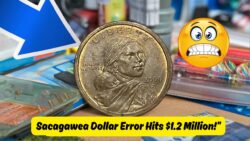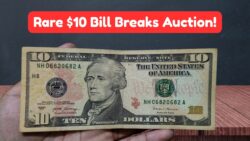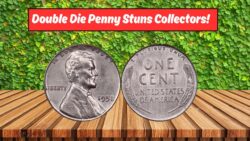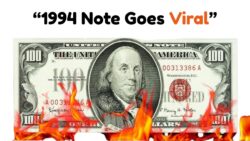1863 Confederate $10 Bill – In the world of rare paper money collecting, some notes stand out not just for their age, but for their powerful historical context and limited circulation. One such note is the 1863 Confederate States of America (CSA) $10 bill, now grabbing the attention of collectors and investors alike. Recently, a well-preserved version of this bill sold for over $18,000 at auction — a staggering return on what was once mere Confederate currency. But what makes this specific note so special, and how can you tell if you have one? Let’s dive into the incredible story behind this Civil War-era currency, its rising value, and what makes it one of the most sought-after collectibles in the paper money world.
The Historical Significance of the 1863 Confederate $10 Bill
During the American Civil War, the Confederate States issued their own currency to support the war effort. These notes were not backed by gold or silver — instead, their value was a promise to pay after the war’s successful conclusion. That never happened. Still, the paper money issued during this period offers deep insight into the Confederate economy and culture.
Why it’s historically important:
- Issued by the Confederate States of America during the Civil War.
- Printed before the fall of the Confederacy in 1865.
- Reflects economic desperation and political identity of the South.
Design Features That Add to Its Value
The 1863 $10 Confederate note features iconic Southern imagery and artistry. These visuals were not only propaganda tools but also served to inspire Southern nationalism.
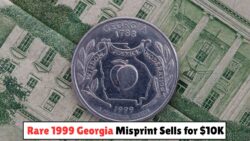 This 1999 Georgia Quarter With Misprint Just Hit $10,000 at Auction – Still in Circulation!
This 1999 Georgia Quarter With Misprint Just Hit $10,000 at Auction – Still in Circulation!
Key design elements include:
- Portrait of R.M.T. Hunter – Confederate Secretary of State.
- Sailing ship vignette – Representing commerce and naval strength.
- Ornate borders and lettering – Hand-engraved for authenticity.
- Hand signatures – Printed in ink, adding uniqueness to every note.
- Serial numbers and plate letters – Help identify rare varieties.
Collectors value pristine artwork and legibility, so notes with minimal wear, strong paper, and no major stains or tears are worth significantly more.
How It Gained Value Over Time
What was once worthless after the Civil War is now a coveted collector’s item. Why? Because scarcity meets demand. With time, fewer notes remain intact, especially those in excellent condition.
Main reasons for the rising value:
- Limited surviving quantity – Most were destroyed or deteriorated.
- High-grade condition – Crisp, uncirculated bills command the highest prices.
- Increased collector demand – Civil War-era memorabilia is extremely popular.
- Auction exposure – Recent high-profile sales drive awareness.
A note in “Fine” or “Very Fine” condition may sell for $1,000–$3,000, while “About Uncirculated” or “Crisp Uncirculated” grades can cross $15,000–$18,000 depending on rarity.
Recent Auctions: $18,000 Sale Explained
One of the most talked-about sales happened this year at a major numismatic auction house. A beautifully preserved 1863 Confederate $10 bill sold for a whopping $18,250 after a bidding war among multiple collectors.
Details of the auction note:
- Graded “Gem Uncirculated 65” by PMG.
- Exceptional centering and deep ink color.
- No pinholes, folds, or damage.
- Complete margins and clear signatures.
The seller had inherited the note from a great-grandparent who lived in Georgia during the Civil War — making it both historically and emotionally valuable.
How to Check if You Own One
Wondering if you have one of these valuable notes sitting in an attic or family album? Here’s how to identify a genuine 1863 Confederate $10 bill.
Look for these signs:
- The year “1863” clearly printed.
- The words “Confederate States of America” on top.
- A portrait on the left side (R.M.T. Hunter).
- A tall sailing ship at the center or right.
- Handwritten serial numbers and signatures.
- Printed on thin, fragile paper (not modern stock).
If you suspect yours might be real and valuable, do not clean, fold, or laminate it. Instead, take it to a certified currency dealer or send it to a grading service like PMG or PCGS Currency for authentication.
Estimated Value Based on Condition
| Condition Level | Description | Estimated Value Range |
|---|---|---|
| Poor | Torn, missing parts, unreadable ink | $50 – $200 |
| Good | Complete but heavily worn | $250 – $800 |
| Fine | Moderate wear, still legible | $800 – $1,800 |
| Very Fine | Slight creases, clear design | $1,800 – $3,500 |
| Extremely Fine | Crisp, minor handling marks | $4,000 – $8,000 |
| About Uncirculated | Sharp corners, no folds | $8,000 – $13,000 |
| Gem Uncirculated | Perfect condition, slabbed and graded | $15,000 – $18,500+ |
Preservation Tips for Rare Confederate Notes
If you own a Confederate $10 bill, preserving it properly is essential for retaining or increasing its value.
Best practices for storage and care:
- Keep in a protective currency sleeve (archival quality).
- Avoid direct sunlight or high humidity.
- Never tape, staple, or glue the bill.
- Store flat in a dark, cool, and dry place.
- Consider professional grading for resale purposes.
The 1863 Confederate $10 bill isn’t just rare paper — it’s a direct link to one of America’s most defining conflicts. As collectors continue to hunt for high-grade specimens, prices are likely to rise even further. Whether inherited, discovered, or bought, this piece of Southern history carries enormous financial and emotional value. If you think you might have one, get it authenticated — it could be worth thousands.
FAQs:
Q1. How can I tell if my 1863 Confederate bill is real?
A1. Look for handwritten signatures, fragile paper, period design elements, and clear “1863” markings. For confirmation, consult a certified currency expert.
Q2. Are Confederate bills legal to sell?
A2. Yes, Confederate currency is legal to own, sell, and trade as collectible historical artifacts.
Q3. Can damaged Confederate bills still be valuable?
A3. Yes, but value decreases with damage. Even worn notes may fetch hundreds depending on rarity.
Q4. Where can I get my Confederate bill appraised?
A4. Visit a reputable numismatic dealer or send it to grading services like PMG or PCGS for evaluation.
Q5. Why are these notes so valuable if they’re not legal tender?
A5. Their value comes from historical significance, scarcity, and demand among collectors — not their purchasing power.


